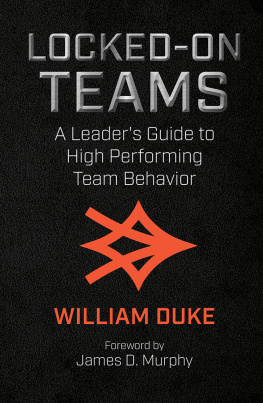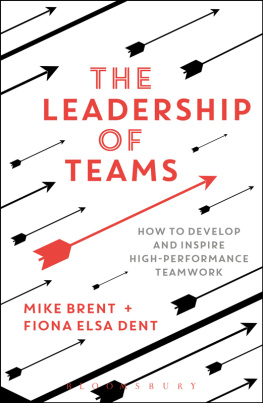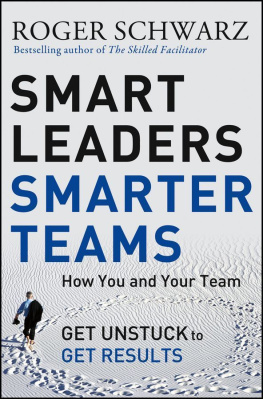Acknowledgments
Victor Prince:
Pat and Galefor leading me by example my whole life.
Tinafor inspiration.
Mikefor a wonderful partnership.
Giles Andersonfor being my favorite literary agent.
Adam Schwartz and the rest of the Career Press teamfor making this happen.
Alexander and Charlesfor blazing the trail for authors in the family.
Amy G., Bob B., Bruce E., Catherine W., Dan D., Dan T., Dean D., Jerry Y., Judith R., Katherine B., Liddy M., Neil A., Paul W., Ray B., Rich C., and Rich W.for teaching me leadership firsthand by being a great boss, teacher, or coach to me at some point in my life.
To all my family and friends who asked me at some point about how The Book was coming alongwriting a first book is a lonely, uncharted trek with no guaranteed finish line. Even the smallest gestures of interest and support meant more than you realized.
Mike Figliuolo:
Danielle, Michael, and AlexandraDont know what Id do without your love, support, humor, and perspective. Youre my treasures.
Mom and DadI appreciate all youve done and who you are more every day.
Ginaa million thanks to for the smiles and love. I still laugh every time I make mashed potatoes or waffles.
Nana, Pop, Grandma, and Grandpanot only did you love me unconditionally, you taught me a person can be kind and humble while still being special.
The rest of my familyevery single one of you is crazy in the most wonderful way. I couldnt ask for more perfect company. I love all of you.
Victorthank you for including me in your idea and for being a great writing partner.
J. and T.your continued guidance is a blessing.
Giles Andersonyour persistence, encouragement, and guidance are invaluable.
Adam Schwartz and the Career Press teamthank you for giving us the opportunity to share our passion for leadership with the world.
My teachers and coachesfor filling my head and my heart with wonderful knowledge.
Dr. Chapekis and the OhioHealth Teamfor literally saving my life so I could be around to write this book (among other things).
My leadersfor teaching me what it means to lead and for setting a great example.
My team memberswow. Thanks for supporting me and always making me look good.
My clientsyou make living the dream of my present career possible.
My friends and colleaguesIm blessed that those two titles are synonymous.
Appendix A: The Leadership Matrix Assessment
To assess your team members behaviors, examine how much leadership capital youre investing in them. Ask yourself the questions in this Appendix about their delivery of results. Evaluate their behavior throughout the past year to avoid a recency effect skewing the results. As you answer the questions, write down instances of observed behaviors to support your answer. Having concrete examples allows you to identify targeted behaviors to change, or maintain, as the case might be. Those observations guide your provision of feedback and coaching to that team member so he knows what behaviors he needs to change. For each dimension or question, weve offered an example of clear documentation of an observed behavior. There are examples of both good and bad behaviors to give you a sense for how you can document your team members performance.
For conveniences sake, weve made this assessment available online at www.leadinsidethebox.com/assessment. In the online version, you can answer all the following questions, include comments to support your answers, and get a custom report on that team member emailed directly to you. You can assess as many team members as you like and use the reports as documentation of their progress.
Input (Leadership Capital) The 12 Leadership Services
Answer yes if this team member uses the service in question more than expected.
1. DirectingPlanning, Prioritizing, and Coordinating
2. DoingDeciding, Motivating, and Clearing
3. DeliveringMonitoring, Correcting, and Repairing
4. DevelopingTraining, Coaching, and Promoting
Directing
Planning: Leaders translate their vision for the organization into team goals and further into individual goals. Your team members should be responsible for determining how to achieve their goals. Are you spending more energy than you should managing this persons individual goal definition and how shell achieve those goals?
Example: Tim missed his budget this quarter and came to me with a recovery plan that only recaptured half of the shortfall. After sharing his results, he said, I dont know what to do to fix this. When I asked about his plan to close the gap, he said, Cant you provide me with relief from your other teams?
Example: Alan helps his colleagues to identify risks to their budgets. He works with them to put contingency plans in place in the event of negative results. He budgets conservatively and identifies all the initiatives and tactics for achieving his goals with room to spare.
Prioritizing: Determining priorities is important. A large consumer of leadership capital is changing priorities and then reallocating resources accordingly. Team member behaviors can force leaders to reprioritize work and shift resources. Does this person need you to cover his shortfallsby reprioritizing work and shifting resources more than he should?
Example: Rebecca often miscalculates the resources she needs. The most recent example is that she requested an additional $57,500 beyond her budget of $423,000 for two additional contractors to complete her project.
Example: Gail has never asked for additional resources to complete any of her work in the last two and a half years. She plans her work meticulously and finds creative ways to follow her constraints when things dont go according to plan.
Coordinating: Leaders provide their team members with broader organizational perspectives and make connections for them. Your people should be able to make many of these connections themselves. Does this person require you to spend more time and energy than you should helping her coordinate with others across the organization?
Example: Keith often complains that he feels left out of the loop and that he never has support for his projects. I frequently have to remind him to assess his stakeholders and seek their input. On five occasions in the past six months I had to insist he set meetings with other departmental leaders to get their perspectives on his primary project.
Example: Mark invests time in building relationships within the team by scheduling lunch and learn sessions with his colleagues every other week. His goal in doing so is learning about what his peers are working on. Mark manages a Key Stakeholder Relationship Matrix for how he interacts and influences people across the company. Hes done so for more than a year.
Doing
Deciding: Leaders make decisions that cant or shouldnt be made by their team members. Your team members should differentiate between decisions they escalate to you and ones they shouldnt. Are you helping this person make many decisions he should be making on his own?
Example: Don made four purchasing decisions this year that were well above his level of decision-making authority. He was aware of his decision limits and still elected to make the decision without getting my approval. One such decision delayed a major project by three weeks because of problems hecaused for our vendor partner. These were decisions he should not have made.










